Wiley Turner died in 1851 in Lowndes County Alabama. The first inventory of his personal property, including those enslaved on his plantation, took place in 1852. You can see a list of names, ages and “values” in this post – Joe Turner in the 1852 Estate File of Wiley Turner. The second inventory was taken in 1856 when the oldest child came of age – Second Inventory of Wiley Turner’s Estate – 1856.
The third inventory was taken when the second child, James Mosely Turner, reached the age of 21 and wanted his share of the estate. #63. Yellow Joe, was my great great grandfather. Click on any image to enlarge.
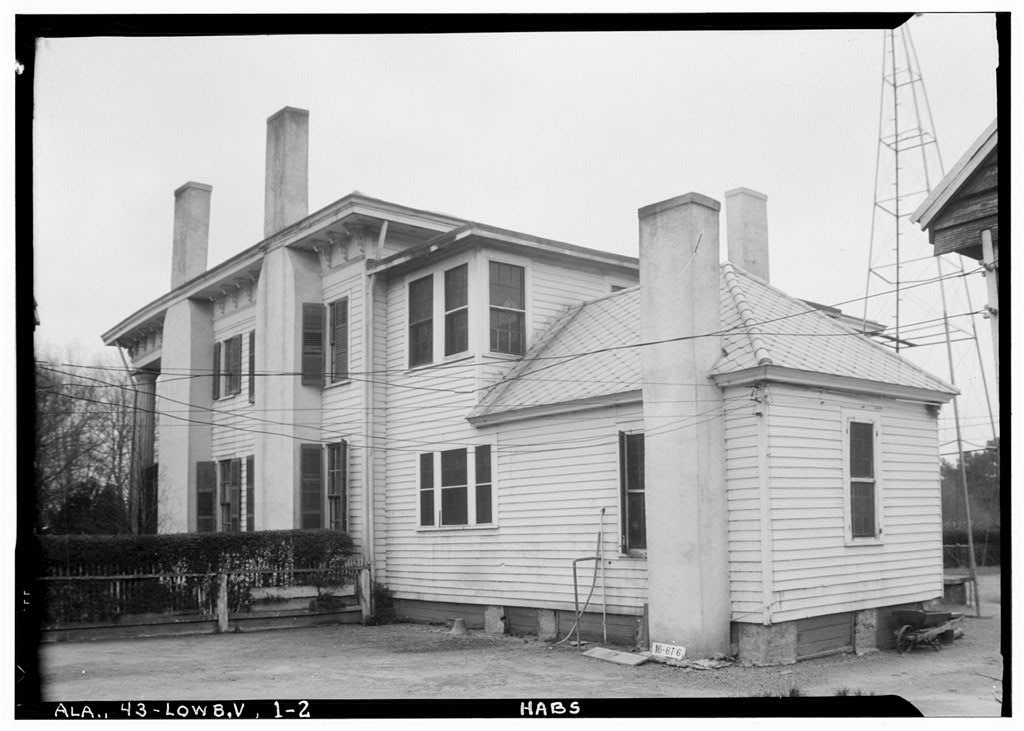
The State of Alabama}
Lowndes County}
To the Honorable E.H. Cook, Judge of Probate for said county The undersigned commissioners under and by virtue of the accompanying and foregoing commission by your Honor made and directed to them to divide the personal Estate of Wiley Turner deceased so as to set off one fifth thereof to James Turner one of the Heirs and distributees of said deceased shows that in conformity with said order after first having taken an oath before a Justice of the Peace to make such distribution fairly and impartially if the same can be made the proceeded on the 21st of December 1857 and continued and continuous until the 8th of January 1858 to divide and value the personal property of deceased as follows ______
Valuation of entire slave property of deceased – names of
- Andrew $1,300
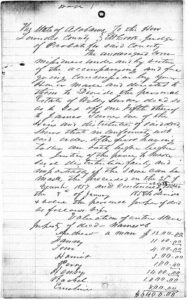
- Fanny 1,100
- Tom 400
- Harriett 300
- Perry 100
- Henry 1,400
- Rachel 1,000
- Emeline 800
- Robin, little 1,000
- Frank 800
- Fed (Ned?) 1,100
- Clara 700
- Julia 550
- Albert 500
- Freeman 800
- Harrison 800
- Lucy 1,100
- Henry Turner 1,200
- Lloyd 1,200
- Margaret 700
- Nelson 1,250
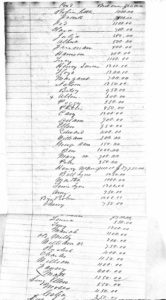
- Betsy 950
- Allen 300
- Peggy 550
- Phillis 850
- Cary 1,700
- Adam 900
- Ellen 950
- Edward 400
- William 300
- George Ann 150
- Ben 1,000
- Mary 900
- Peter 350
- Henry McQueen 1,000
- Bill Tyus 1,250
- Martha 1,000
- Lewis Tyus 1,200
- Amy 950
- Big Robin 1,200
- Cherry 750
- Prince 730
- Louisa 350
- Tony 1,200
- Mariah 1,100
- Old Milly 200
- William @@ 750
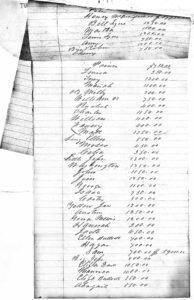
- Rachel 400
- Charles 1,500
- William 400
- Fanny 600
- Matt 1,350
- Long Ellen 550
- Moses 450
- Celia 350
- Little Jesse 1,300
- Washington 1,250
- John 1,150
- Jim 1,250
- George 1,100
- Isaac 950
- Carter 800
- Yellow Joe 1,200
- Austin 1,250
- George Morris 1,200
- Hannah 200
- Jack 650
- Ellen Bullock 700
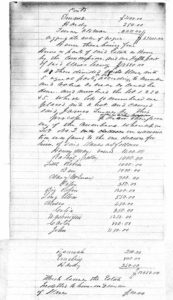
- Hagar 700
- Sam 700
- Big Jesse 800
- Eliza dark 1,050
- Manerva 1,000
- Eliza Bullock 350
- Abigail 550
- Emma 400
- Handy 250
- Turner old man 000
James Wiley Turner’s Lot consisted of:
- Henry May
- Rachel Patten
- Little Robin
- Ben
- Mary McQueen
- Peter
- Big Robin
- Long Ellen
- Moses
- Celia
- Washington
- Carter
- John
- Hannah
- Emeline
- Handy
Related Links:
The first list which was made in 1853 > Joe Turner in the 1852 Estate File of Wiley Turner
Second Inventory of Wiley Turner’s Estate – 1856
An article about valuation of the enslaved. It includes several charts about valuation at various ages and in various years, showing that (as I saw in these lists) values soared from 1852 to 1861 – Measuring Worth
When/how was the first time you came to know that Yellow Joe was your great great grandfather, Kristin? Seeing his name written down like this must have been thrilling when you first discovered it. But at the same time it gives a sickening feeling in the pit of the stomach.
Josna
I knew that he lived in that area of Lowndes County and I knew that he was as light as a white person because my grandmother told me he and her father looked something like her grandfather Dock Allen and like her husband Mershell Graham. What they had in common was they both were very light and looked white.
Wiley Turner was one of the largest slave holders in Lowndes County. I always set up a tree on ancestry for known and suspected slave holders, so I set one up for him and when I found his probate record with all the lists of those enslaved over the years, I was quite interested to see if I could find my 2X great grandparents – Joe and Emma Turner.
In each list there is one Joe. In the first one Joe was described as Joe (white). After freedom, in the 1870 census (the first one that enumerated black people by name) there was only one Joe Turner in that area – my 2X great grandfather, Joe Turner.
I have been very glad to have found him in this file. I did not find my great great grandmother, Emma Jones so I am still looking for her.
So it’s part systematic slogging, part process of elimination, part inspired and educated guesswork. Here’s hoping you find your great great grandmother too!
I had a long talk with my cousin in England, who told me that she has started looking for our grandparents’ grave(s). She got as far as the coordinates–J6–but couldn’t find the actual grave. Next time I’m there we’re going to try to look for it together.
Yes all of that plus spending way to much time sitting here at the computer doing it.
I hope you all find it! Having the coordinates should help.
Was there a system for deciding one’s value? I get that a strapping young 20-yr old male was more valuable than a 3-yr old girl, but . . . .
I have added a link to the first list, made several months after Wiley Turner’s death that lists name, sex, age and value. Here is something I just found “Figure 1 demonstrates how the price of slaves varied with respect to age, sex, and location during the antebellum period. As one can see, prices were higher in the New South than in the Old South (the states along the Atlantic coast) and higher for males than for females7. The statistics on slave prices show that healthy young adult men in the prime of their working lives had the highest price, followed by females in the childbearing years. Young adult males had more value as they were stronger, could work harder in the fields, and could be expected to work at such a level for more years. Young adult women had value over and above their ability to work in the fields; they were able to have children who by law were also slaves of the owner of the mother. Old and infirm slaves had low, even “negative,” prices because their maintenance costs were potentially higher than the value of their production. Similarly, young children had low prices because the “cost” of raising them usually exceeded their annual production until they became teenagers.” https://www.measuringworth.com/slavery.php. There is even a little chart going from under 5 years old to over 60 years old. Not sure about the “but…” in your comment above and hope this answers it.
As usual, I am so impressed with the sophistication of your research. We must be reminded, frequently, of the reality of our history.
Thank you Kathleen.
This is very powerful history, Kristin. I’ve read all the names and prices and still I’m very troubled to understand the mindset of a Southern slave owner. Making a property list of human beings seems such an abhorrent concept in 2017, yet for the executors of Wiley Turner’s estate it was strictly business. Number 78, Turner old man – $000 was the most startling.
I belong to a History Book Club and over the last few years we’ve been reading mainly books on American history beginning with the early colonial era. This year we completed several books on the Civil War and then on Reconstruction. We’re at about 1900 now.
Perhaps the most compelling book I’ve read in the club was: American Slave Coast: A History of the Slave-Breeding Industry
by Ned Sublette and Constance Sublette. While reading it I marked several passages on the valuation of slaves. But until I read this book I did not understand that slave prices were driven by supply and demand. When each decade of the early 19th century brought a new expansion of America, i.e. Alabama/ Mississippi, then Louisiana, then Texas, etc., more slaves were needed for the new cash crops – sugar, cotton, etc. This book goes into great detail on how the trading and breeding of slaves worked.
When estates like Wiley Turner’s were broken up, the value was never in bank accounts, or stocks and bonds, or even in land, which was never a very liquid commodity. The worth was measured in human beings. Easily sold and traded for profit. Seeing your 2X great grandfather’s name in such a hand written document makes this horrid history of America more vivid. Thank you.